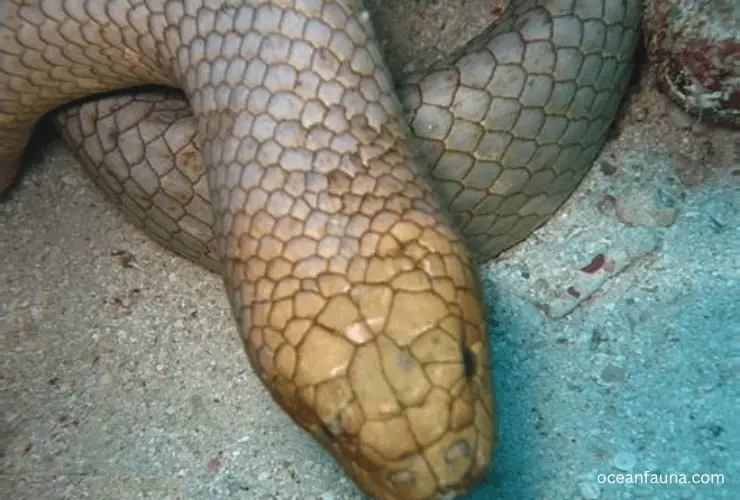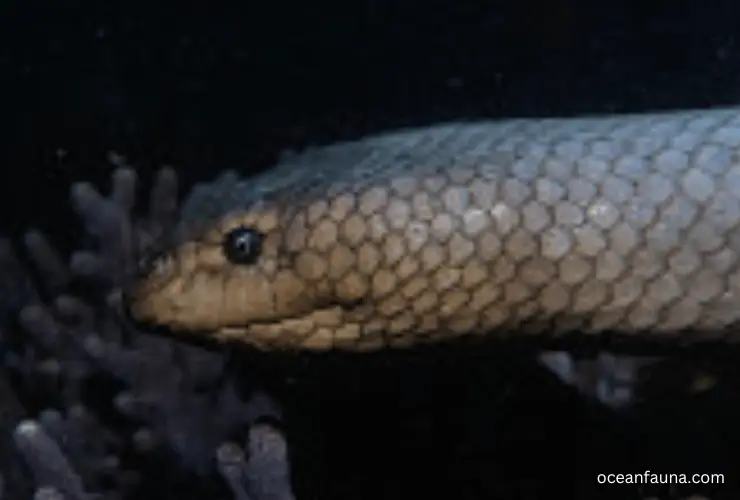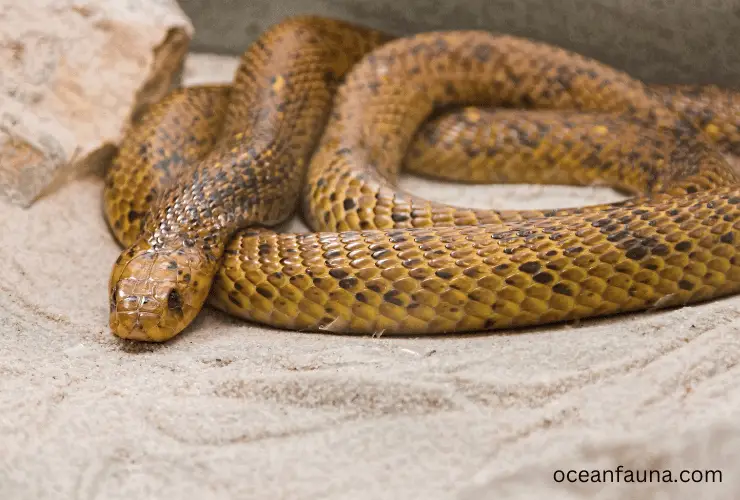Aipysurus laevis, also known as the olive sea snake, is one of the most incredible snakes in the world. This Indo-Pacific living sea snake is a renowned venomous sea snake whose etymology will surprise you. This marine snake is really interesting to see and discuss.
You can call it by many names. Due to its colorization, the most common names for Aipysurus laevis are golden sea snake, olive-brown sea snake, and olive sea snake. Aipysurus laevis is its scientific name. No doubt, this is a common species of snake but unique and distinct amongst the other sea snakes.
Are you interested to know more about its living habits and appetite? Are you curious to indulge in the gory details about the Aipysurus laevis’s related questions? We are here to help you out with that. Just read on to know more about it.
About Aipysurus laevis: Facts and Features
● Kingdom: Animalia
● Phylum: Chordata
● Class: Reptilia
● Order: Squamata
● Suborder: Serpentes
● Family: Elapidae
● Genus: Aipysurus
● Species: A. laevis
● Biological name: Aipysurus laevis
● Size: length of one to two meters
● Lifespan: approximately 15 years
● Endangered status: least concerned
Aipysurus laevis Habitat and Lifestyle
The habits and lifestyle of Aipysurus laevis are worth mentioning. Let’s go through it!
Physical characteristics It has various names that are used to describe its physical characteristics, like the smooth scales on its back. These scales are olive-brown, olive-gray, or even golden colors. The belly of Aipysurus laevis is white or cream.
It has two dark and large eyes. Its length varies from two to three feet, and its weight from six to seven pounds. What about the tail? It’s flat and paddle-like and helps to propel it in the seawater. Its tail looks like a little eel.
Thus, whenever you encounter an olive sea snake, you can easily identify it with its:
● Flat tail
● Dark and large eyes
● White or cream underbelly
● Smooth scales of olive-gray, olive brown, or golden colors.
Its rings fade out with age. The flattened tail and beautiful scales make it an important family of elapid snakes.
Diet & Nutrition
Aipysurus laevis is a carnivore eater. It loves to eat crustaceans, mollusks, fish, and fish eggs. The derived characteristic of Aipysurus laevis in its special diet makes it unique.
Environment researchers have called them generalized predators. They stated:
“The diet of Aipysurus laevis includes 19 species from 17 distinct families of fish. These snakes also eat invertebrates like crabs, shrimps, and file shells. Their diet varied from a geographic and temporal point of view.” (Source)
Development
Encyclopedia of Life has talked about the development cycle of Aipysurus laevis in the best way:
“Olive sea snakes, like many other species of snake, experience a significant slowing of their growth rate at reaching sexual maturity. It takes males around three years of age and females around four to five years of age to reach sexual maturity.” (Source)
Research Gate’s researchers have also quoted the following words for the growth of these snakes:
“Aipysurus laevis (Lacépède) sea snakes grow at a pace of 0.22 to 0.95 centimeters per month, with younger animals developing at a higher rate. And females are heavier than males.” (Source)
Reproduction
The researchers of Sea Life Base in the following words thoroughly explain reproduction behavior:
“Males tend to be smaller than women. This snake is viviparous, giving birth to anywhere from one to five healthy, full-grown young.
A complete year may be needed for adipose tissue renewal, given that the gestation period is roughly 9 months, and only half of the females appear to be gravid at the same time (biennial reproduction).
It has a continuous yearly reproduction cycle. When two or more male who looks more frantic than usual meet, they start sticking out and pulling in their tongues at breakneck speed. Get worked up when they find a receptive female who also sticks out her tongue and retracts it.
Together, the chosen male and receptive female can coil and uncoil into a more powerful unit. During mating, the male repeatedly smacks the female on the nape of her neck when the two of them are tightly coiled together.” (Source)
Behavior and Humans
The size and strength of Aipysurus laevis are very imposing. These snakes are not harsh towards humans, but they are venomous. However, they deserve respect just like other sea creatures.
Scuba divers often encounter an Aipysurus laevis sea snake when they dive into seawater. These sea snakes swim around the divers due to curiosity but do not bite. However, their bites are fatal.
Inadvertently catching golden sea snakes in their massive nets is a common problem for fishermen. The possibility of a poisonous bite is present in this scenario. While trying to catch or release a sea snake, a fisherman runs the risk of being bitten.
Predators
Although they are venomous creatures, some predators are always over there to kill and eat them. These predators do not have any mercy for these snakes if they catch them.
Ospreys and sharks are two of their predators. They use their “Seeing” tails to avoid predators. They pretend their tails as mouths and protect them.
Where to Find Aipysurus laevis Snakes?
Although they can go and live anywhere on the earth, they are found mostly on coral reefs. It also includes the Great Barrier Reef. The northeastern Pacific Ocean is their favorite place to live and enjoy life freely.

They live in these areas because of their small coves and protective coral areas. These coves help them to hide and protect them from predators. Aipysurus laevis is also found on the coasts of Australia and Papua New Guinea.
DoveMed article has given the geographic distribution of aipysurus laevis: (Source)
● Northern and western parts of Australia bordering the states of Western Australia, Northern Territory, and Queensland
● Island nations to the north of Australia include New Guinea (part of Indonesia), Papua New Guinea, Timor-Leste and surrounding islands, New Caledonia, Loyalty Islands, etc.
● Great Barrier Reef off the east Australian coast
These are some of the locations where aipysurus laevis can be seen easily. However, do not provoke them because they can bite you and kill you on the spot.
Aipysurus Laevis Population and Conservation Status
“The Red List of Threatened and Endangered Species” from IUCN has mentioned the aipysurus laevis as the most common and widely found sea snake species. It’s commonly seen in Australia. Its conservation status is reported as “stable”.
However, the correct population status still needs to be reported. Conservationists and reporters have classified this sea snake as “Least Concern”. We need to find out the reason behind this status. But it’s indeed widely abandoned, and its population is OK, not endangered.
The Action Plan for Australian Lizards and Snakes 2017 has also listed it as “Least Concern”. Thus, both of the documents have confirmed that these marine snakes are less interesting and are found all over the world. (Source)
How Do Aipysurus Laevis Sea Snakes Hunt?
How do olive sea snakes hunt? This is one of the commonly asked questions from the perspective of the Google Search Engine. Let’s answer it in detail and see what Wikipedia has stated about it.
“It paralyzes its prey with venom. Specific enzymes in this snake’s venom facilitate the animal’s digestion. The venom has an effect on the prey’s muscles and nerves, and it is the most toxic sea snake venom in terms of volume.

The snake typically forages in coral reef environments, inspecting cracks and crevices with its head. If it can help it, the creature avoids hunting in open water. This is how they hunt their prey and eat them.” (Source)
The Oceana organization has been talking about facts about these sea snakes for a long time. The researchers have investigated the aipysurus laevis hunting habit. The authors have written:
“Olive sea snakes are predators, preying on a variety of marine life from prawns and crabs to smaller fish and other benthic invertebrates. It is nocturnal and rarely seen during the day, emerging only to catch its breath.” (Source)
Is Aipysurus Laevis Venomous?
Aipysurus laevis is a highly venomous sea snake. It’s also reported by various SCUBA divers who encounter unprovoked “attacks” by olive sea snakes. These attacks were highly venomous and fatal. Laboratories have suggested that this snake’s venom is highly toxic. (Source)
The authors of Nature.com have naturally given the reason behind their venomous bites.
“In their pursuit of divers, snakes may swim directly at them, coiling around their limbs and biting if they get too close. It was the males, not the females, who approached divers the most frequently throughout the winter breeding season.
These occurrences are consistent with sexual confusion being the cause of “attacks” by sea snakes on humans. Divers should remain still and refrain from fighting back in order to defuse potentially dangerous situations.” (Source)
How Venomous Is the Aipysurus Laevis Snake?
Aipysurus laevis is a highly venomous sea snake. Its venomous bite can kill you at the moment. This is the reason this snake is one of the deadliest sea snakes all over the world.
It belongs to the family of Elapidae. These snakes are highly venomous and swift-moving snakes. Other names for this condition include:
● Aipysurus Laevis Snake Bite
● Golden Sea Snake Bite
● Olive Sea Snake Bite
These snakes are also referred to as coral reef snakes and truly aquatic sea snakes. DoveMed has talked about its venom in these words:
“Sometimes people don’t even realize they’ve been bitten by a sea snake since the bite is so mild or causes so little discomfort. Even yet, envenomation (venom injection) from an Olive Brown Sea Snake Bite can be extremely dangerous. It is fatal if not treated quickly and properly.” (Source)
What Are the Symptoms of Aipysurus Laevis Bite?
Whether a youngster or an adult, as well as their size and general health, play a role in the manifestation of symptoms following a snake bite (whether having an underlying condition or illness). Moreover, the symptoms change depending on the venom’s intensity and the amount.
The symptoms of the olive sea snake bite vary from person to person. The initial signs can be observed after five minutes to two hours after the venomous bite. Initial symptoms include:
● Fang marks on the bitten area.
● Swelling at the bite site
● Nausea, Vomiting, and Diaherra
● The feeling of a thick tongue
● Dryness of throat
● Muscles ache or stiffness in the body
● Fatigue, pain, and weakness in the muscles
● Headaches
● Sweaty feeling
● Anxiety, suffocation, and drowsiness
Here a question arises what are the symptoms of the aipysurus laevis bite if several hours have passed? The passed hours may be four to eight. The signs may include the following:
● Abdominal pain
● Poor reflexes
● Locally enlarged lymph nodes
● Drooling from the mouth
● Trismus
● Droopy eyelids
● Blurred vision
● Breathing difficulties
● Blabbering
● Feeling faint
● Dark-colored urine
● Blue-colored skin
● Weakness and malaise
● Unconsciousness
Paralysis, respiratory failure, and/or cardiac arrest may develop rapidly from the earliest signs in many circumstances. So, what are the systemic symptoms of aipysurus laevis venomous bite?
Systemic signs may include:
● Generalized muscle damage
● Rhabdomyolysis
● Paralysis of voluntary muscles
● Difficulty speaking and swallowing
● Moderate to severe paralysis
● Kidney failure
Is There Any Antivenom for The Aipysurus Laevis Bite?
The first 6-8 hours after a sea snake bite are the most critical for preventing life-threatening symptoms. So, all bites should be treated as medical emergencies and evaluated by competent medical personnel as quickly as possible. The risk of serious complications or even death increases if the patient does not immediately receive any treatment or antivenom.
Monovalent antivenom or polyvalent antivenom may be the best antivenom for Aipysurus Laevis venomous bites. NCBI researchers recommend Biosynthetic Oligoclonical Antivenom (BOA) for olive sea snakes as a good treatment. (Source)
However, antivenom is not always the solution; sometimes, the communities lack antivenom. So what to do in this situation? Hospitalization is necessary in case of severe envenomation.
Compression bandaging, limb immobilization, and vital sign monitoring are all examples of urgent first-aid care and assistance. These should be administered to patients before they are sent to the hospital.
You can also address good hydration to prevent kidney failure. Pain medications can also be helpful here from the recommendations of specialists. Always consult a medical toxicologist for anti-snake venom.
Olive Sea Snake Interesting Facts – Aipysurus laevis
Here are a few fun facts about Aipysurus laevis sea snakes:
● It can stay in the water for more than two hours without taking a breath. (Source)
● It can be found in only brown, olive, and gray colors. If it’s not in these colors, then they are other reptiles, not Aipysurus laevis.
● Aipysurus laevis has valves in its nose to keep water out when it swims in seawater. Strange but factual!
● It usually stays in the coral reef biomes to hide in rocks and vegetation.
● It’s not aggressive and fierce, but it’s a reality that its venom can cause human death.
● It sheds its skin underwater by rubbing itself with hard substances like rocks.
I hope you found these facts fascinating!
FAQs
Do sea snakes breathe air?
Yes, sea snakes need to breathe air, unlike fish. They return to the surface to breathe after swimming or staying on the underwater surface. They surface after thirty to eight hours of staying in the deep seawater for breathing.
Are Aipysurus laevis aggressive?
No, aipysurus laevis are not aggressive. Like other marine animals, it can bite if provoked or feel threatened. These sea snakes swim around the divers due to curiosity.
Is the Aipysurus laevis sea snake poisonous?
Yes, the aipysurus laevis sea snake is poisonous. Its venom is powerful and fast-acting. That’s why it has caused many human deaths.
Does Aipysurus laevis bite divers?
Yes, divers have been reported in the past who were bitten by aipysurus laevis. Some of them survived and some of the divers passed away.
What’s the difference between Aipysurus laevis and hagfish?
There are many differences between the aipysurus laevis and hagfish. The key differences include the following:
● Aipysurus laevis is a reptile, and hagfish is fish.
● Aipysurus laevis breathe air, and hagfish breathe water.
● Aipysurus laevis have jaws and hagfish do not have jaws.
● Hagfish live deep in the bottom oceans, and aipysurus laevis live among coral reefs.
How big do Aipysurus laevis sea snakes get?
Aipysurus laevis sea snakes can get big, up to three to six feet long. However, there are many olive sea snakes whose lengths are up to 6.3 feet. Thus, they have a height of a young human. Its weight can get up to six and a half pounds.
Conclusion
We have seen that aipysurus laevis sea snakes are one of the fascinating species of reptiles. These venomous sea snakes can be recognized easily from their appearances and behaviors. I hope we have covered every query related to these deadly yet exquisite beasts.

